Three riders, three sleds and a quest for the best mountain snowmobile. It should be an easy process--you line them up and grab the throttle. First to the top wins.
But it's never that easy. All three riders are experienced in mountain riding, yet have relatively different skill sets. All three sleds require relatively different approaches to the ride.
So what if each rider rides each sled? What insights might we gain there?
We took a twisty course that went down through a creek bottom, up across a sidehill, through a patch of trees and then up a steep slope and over the ridge—your basic terrain ride where you go from point A to point B in the straightest line possible.
The most aggressive rider of the three had no problems running the course with any of the three sleds. He was fastest on the Polaris, closely followed by the Ski-Doo and then the Cat. All three sleds responded about how he anticipated.
The second rider managed to get all three up the course. However, he bounced off line a couple of times on the Polaris and blew through a couple of the off-camber turns with the Cat. He was fastest on the Ski-Doo, followed by the Polaris and Cat. The Ski-Doo was easy to keep on course while the Polaris would over-steer and at times the Cat did whatever the Cat wanted to do.
The final rider, the oldest of the three, managed to only make it to the top on the first run with the Ski-Doo. He over-corrected coming out of the trees and totally lost his line on the Polaris. He did manage to make it up after three attempts, each failure caused by the rider being out of position on his sled. On the first run with the Cat he lost his sidehill and ended up back down in the creek. The same thing happened on his second attempt. The third time he was scrubbed off line in the trees.
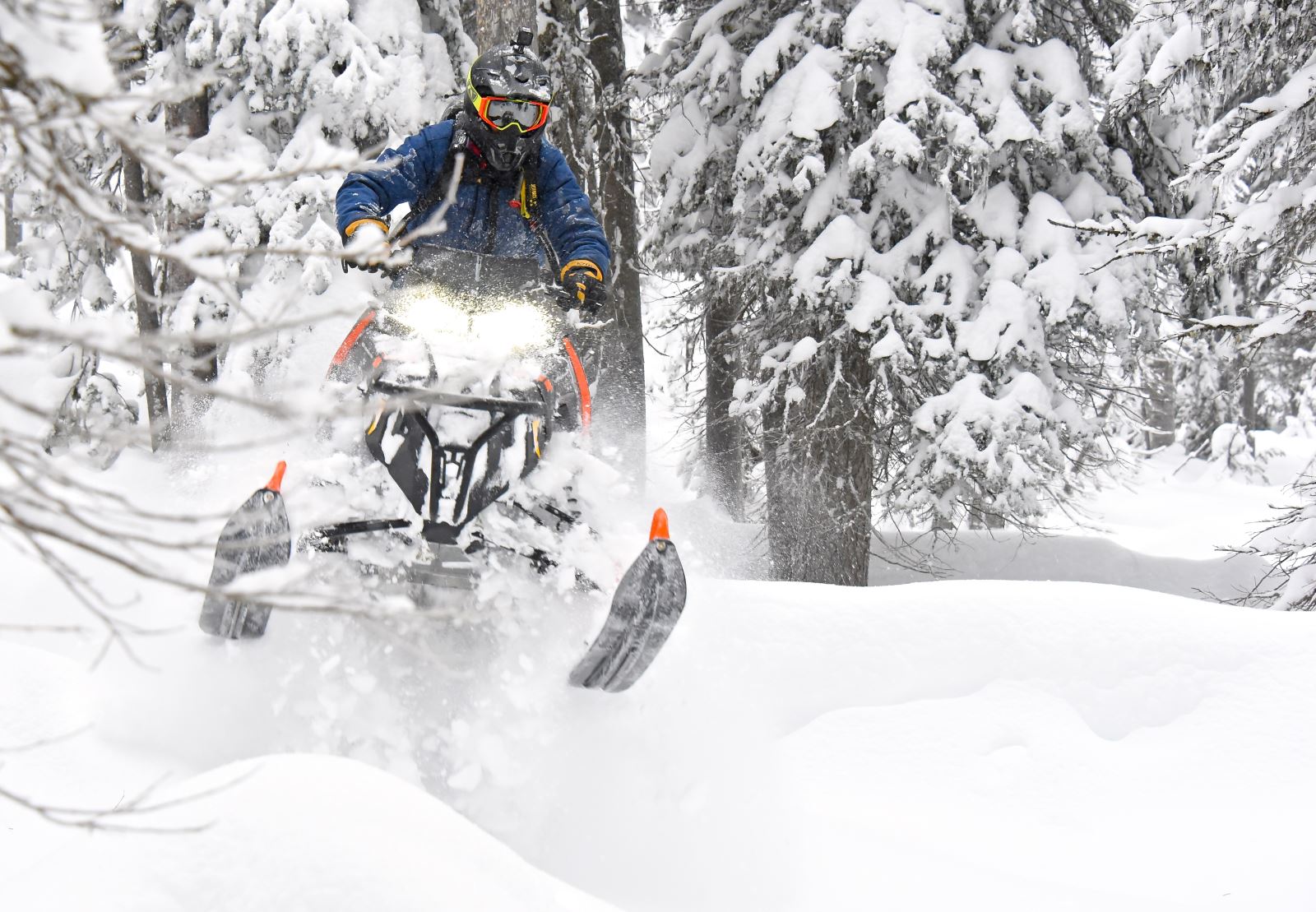
On multiple tests throughout seven days and covering a combined 1,000 miles we concluded that the 2017 Ski-Doo Summit SP is the most versatile mountain sled on the snow—capable of making good riders better and better riders less worn out at the end of the day—edging out the 2017 Polaris 800 Pro RMK and Arctic Cat M8000 Sno Pro (we would have preferred the Mountain Cat; however, it was a spring-only model). The Polaris had the three-inch track which requires a chaincase, adding a little to the weight and a little more trenching than the 2.6-inch track with belt drive.
Not to over-sell the conclusion, all three snowmobiles are very capable of getting you where you need to go. But Ski-Doo has the power, the ride and the flotation to allow you to be as aggressive, or as cautious, as you desire as you pick your way through unforgiving terrain.
The ultimate question asked of our test riders was simple: If you wander into a tight canyon with a creek, sidehill, some trees and a steep climb to beat and it is getting late and you don’t want to spend a night in a snow cave, what snowmobile do you want to have under you?
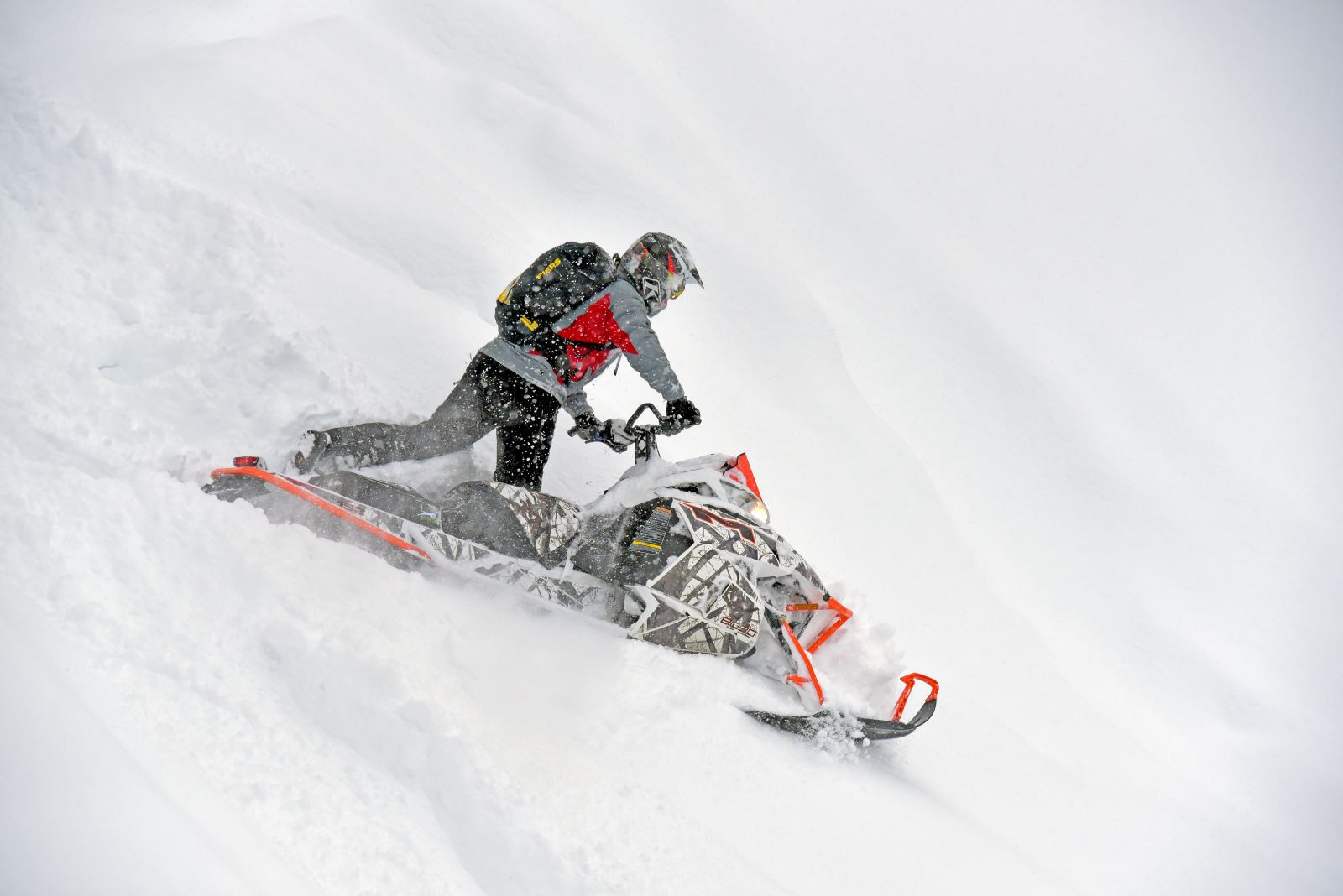
Most of this year’s Deep Powder Challenge testing was done in impromptu conditions. We were fortunate to have plenty of powder, which meant we didn’t have to search out a pocket of untouched snow. We were constantly riding in powder.
Time and again we found ourselves going into drainages with a combination of trees, logs and a meandering creek that was about one third completely covered over with snow, one third covered but showing a depression of the creek and one third opened up with running water just waiting to swallow up your snowmobile. The trouble was that you didn’t know which third you were going to encounter around every bend.
The powder was deep enough you had to stay on the throttle to maintain sufficient momentum to keep moving forward. Yet you had to be quick enough to react to the trees, logs and that pesky creek. If you were slow to react or came up on an obstacle too fast, it was easy to find yourself hung up on a tree or sucked into the creek.
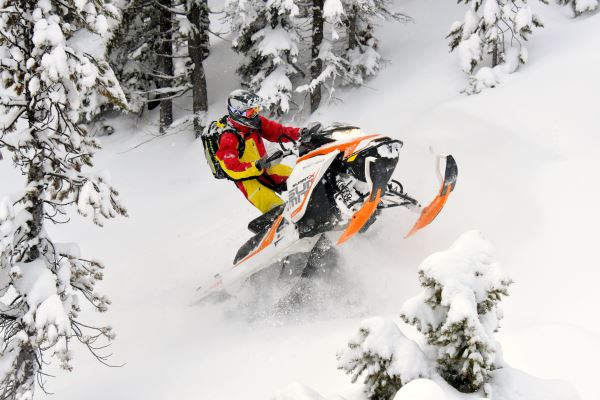
Occasionally, we would be on a ridge and drop down into a honey hole with an abundance of wind-drifted powder. In those instances, where you start down but decide you want to make a hard turn back up the slope, all three were very capable of making the carve and powering back up the slope. Saying that, however, the Cat required the most strength and commitment to change course (strength meaning you had to lean hard and push with your legs and pull with your arms; commitment meaning you had to grab a handful of throttle and trust you could hold your line). But once you got your line, it was very easy to hold.
The Polaris was easy to turn but would often roll up out of the turn, forcing you to dance back and forth until you regained your balance and settled the front end down.
The Ski-Doo was by far the easiest to turn back up and keep it under control. Since it would jump up on the snow quickly, you could make your turn and set your line before you had to get on the throttle.
It’s riding conditions like these that give you the best insight into what snowmobile tends to keep you out of the most trouble.
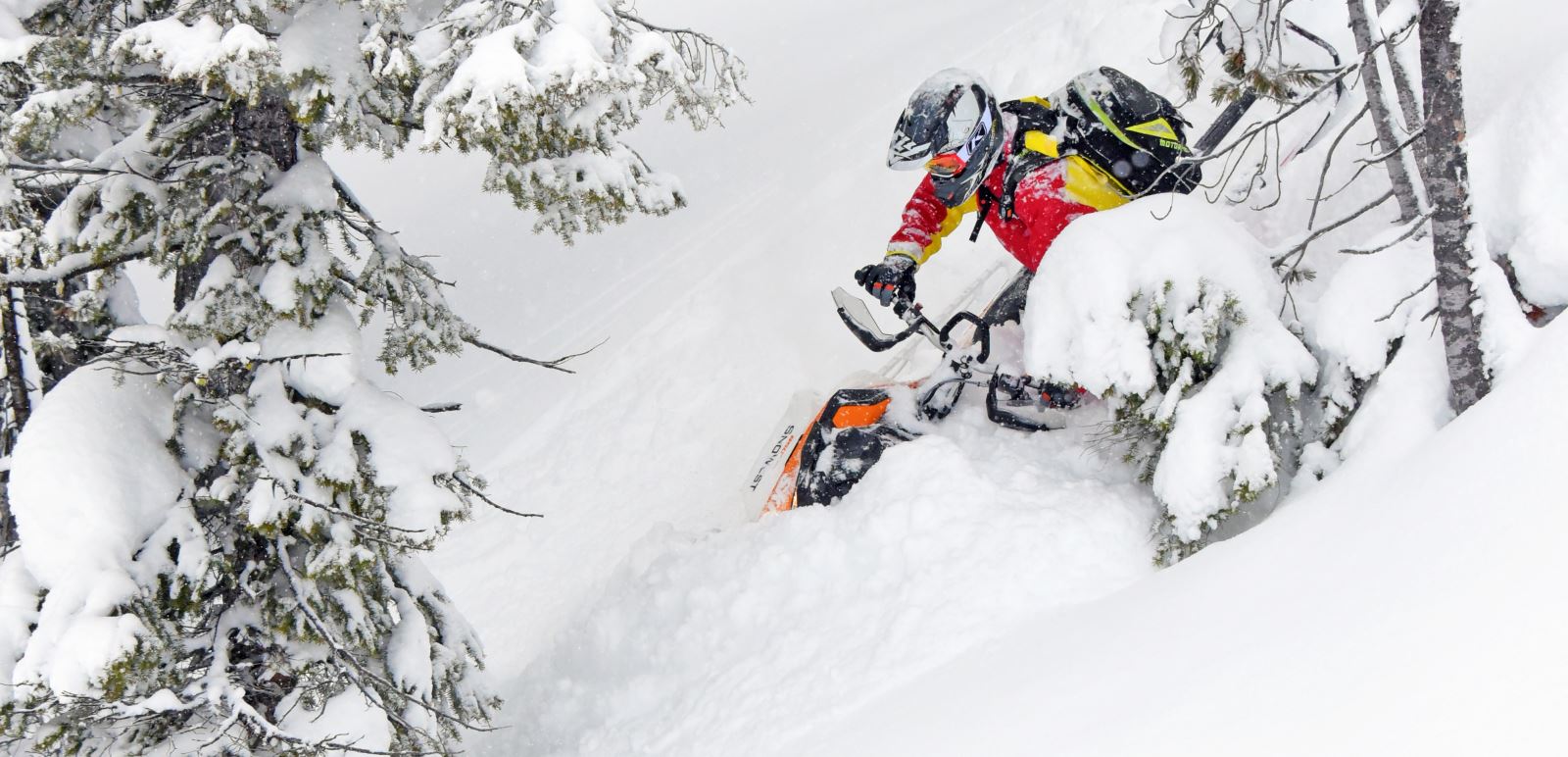
Breaking Down The Sleds
All three snowmobiles have similarities. All three are uniquely different. Polaris and Cat are based on a rigid chassis design (reaction is entirely on rider input). Ski-Doo offers a more flexible design (takes less effort to roll from side to side).
All three sleds boasted a 3-inch track profile. Ski-Doo featured a 165-inch track. Polaris had a 163-inch track and Cat had a 153-inch track. All three tracks worked well in the snow conditions although Ski-Doo definitely had the advantage in flotation. (And all three manufacturers offer sufficient track length and profile options to suit your riding style.)
We did compare a 154-inch Ski-Doo to the 153-inch Cat to see if the difference in track length affected Cat’s performance. The longer tracks do provide a little advantage in flotation. But the shorter tracks tend to handle a little easier, particularly in the trees.
Ski-Doo also has an 849cc engine compared to the Cat’s 794cc and Polaris’ 795cc. You could certainly feel the power advantage of Ski-Doo on the longer pulls.
Anytime you jumped from either of the other two snowmobiles onto the Ski-Doo, there were two things most noticeable: power and ease of ride. The Ski-Doo platform allows you to make turns with little or no effort. You feel like you can ride in slow motion … but you know that whenever you need to grab the throttle you can explode out of the snow.
Another advantage of having a snowmobile capable of riding at slower speeds is that sometimes when you’re in the trees, you’re trying to find lines. If you’re having to creep along at a faster pace in order to keep your momentum, you can pass through your turn before you see your line. When you can creep along at a slower speed, you have the ability to make turns instantly when you see the better line.
We did notice the Ski-Doo clutches getting a little hotter. And the underhood heat did create a slight bog at times when traveling at low speeds when you couldn’t clean the heat out quickly.
Now don’t try to tell a Polaris rider that his sled isn’t as easy to ride as the Ski-Doo. For the same reasons we like the Ski-Doo ride, there are those who dislike it. They feel the Ski-Doo is less predictable with its flexible ride, whereas the Polaris reacts solely on rider input.
The Polaris lends itself to the finesse rider. You have to adjust your weight and feet position to make its rigid chassis perform. If you try to muscle the sled around you tend to over-steer and are constantly trying to correct your balance. It’s the subtle movements that get the sled up on its edge.
Polaris riders love the fact that you don’t need to set up or plan for the next move—just grab the throttle and lean. It is the lightest of the bunch and quick to respond with the throttle.
Polaris also has the best fit and finish. Side panels are solid and don’t feel like cheap plastic. There’s no rattles when the sled is idling. It’s designed to accommodate plenty of storage for your gear. The Polaris is very comfortable to ride.
The Polaris has the state-of-the-art gauge … but has so many features and options that you might never use. It is somewhat complicated (it took me two months to figure out how to reset the tripmeter).
Our biggest complaint about the Cat is actually a compliment to Cat riders—you have to be aggressive to ride it. The Cat is designed to attack the mountain. Its handling characteristics are deeply engineered into throttle response. But that does make it harder to ride for the ever-increasing demographics of older riders who just don’t have the fast reflexes you once did.
The Cat really hooks up. If you keep on the throttle the Cat explodes and goes. It holds a line well. The downside is if you ride it tentatively, if you let off the throttle it has a tendency to dive on the downhill ski. Once it starts to go down, it requires either a lot more muscle or a lot more throttle (or both) to pull it back out of its dive. If you’re in deep snow, it’s not an issue. If you’re in marginal snow, sometimes you just don’t want to do a throttle turn when your skis stand a chance of hitting an unmovable object.
Many riders tend to fight with the Cat’s ride—actually trying to over-muscle the sled which usually results in over-riding it. Then it’s like riding a bull—going from one side to the other while trying to get it pointed straight. Once you get it balanced and pointing straight, the Cat just rips up the slope. The track hooks hard. It takes a little work to get the sled up out of the snow and level on the plane. But once there it goes great.
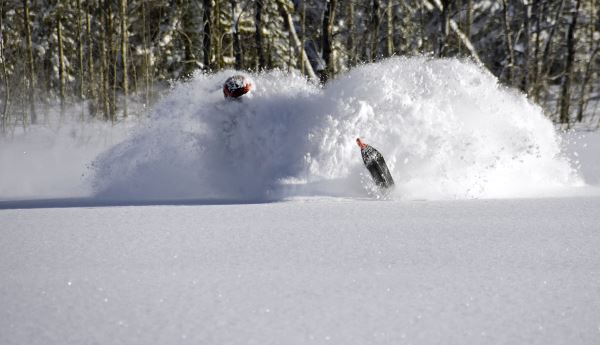
Our test riders just found the Cat requires a lot of energy to control in tight spots in the trees or in unpredictable terrain. Sometimes just the thought of it being heavy makes one a little tentative on the ride. And if you’re tentative, you tend to fight with the snowmobile, regardless of brand. And when you’re out of synch with your snowmobile, you’re going to make riding mistakes.
Rider Comparisons
Results from polling our test riders show that when it comes to power, Ski-Doo comes out the undisputed winner. Yet our riders felt the Cat track was working the best in the deep snow.
Our riders picked the Polaris seat and skis as the best for mountain riding. Polaris also finished out on top when it came to sidehilling.
The Ski-Doo and Polaris virtually tied in clutching, suspension, handling, running boards and handlebars.
The feature that received the lowest scores from our test riders was the Cat skis. And the only area where there was no true consensus was on the Ski-Doo instrumentation—our riders either loved them or hated them.
Black Box Performance Tracker
Always looking for a method to measure hard numbers in an atmosphere that relies heavily on variables, we experimented with some software developed by Black Box Performance Tracker. Scott Niewohner, founder and CEO of BBPT, helped us collect some raw data that was gathered via a phone app designed to rate the rider performance of the snowmobile.
We’ve included this data, but it’s important to note the ratings are based on criteria that is still in a refining stage. Speeds are accurate. However, turn score is based on a formula that measures g-force coming out of a turn. Terrain scores are based on vertical motion by the sled. Performance is based on speed, turns, terrain, jump, endurance and a few other factors that are all mathematically assigned value.
We created an uphill terrain course about one-half mile long with dips, bumps, off-camber turns and sidehilling in relatively soft snow. Taylor Fisk (our younger, more aggressive rider) took two runs up the course so we could average the numbers. Just as a check, Steve Janes (our older rider) took a run with each sled. Janes couldn’t match Fisk on the Polaris or the Cat … but his numbers on the Ski-Doo were very close. The only deduction we take is that the Ski-Doo was easier to keep under control for a rider with slower reflexes.
We will continue to work with BBPT to refine the assessment process of the data and adjust the values of the formula. For additional information contact blackboxperformancetracker.com.

Testing Miles
By stretching our testing period over six weeks, we could take advantage of recent snow storms, allowing us to test mostly in fresh snow. This chart shows you the dates and locations of our test rides.

Weights
(Each snowmobile was full of all fluids, plus had a spare belt—basically ready to ride.)
Ski-Doo Summit 165: 542 lbs
Arctic Cat M8000 153: 567 lbs
Polaris Pro RMK 163: 531 lbs
Driver Weight
Out of curiosity, we wanted to see how driver weight is distributed on a snowmobile. So we took a 200-pound rider and measured his impact on the front and rear of the sled (figuring that most of the weight is likely impacted in the middle).
So we lifted each end with 10 lbs. of pre-weight on the scale to ensure we were starting at the same point in each sample. Below is how the weight was distributed on the ends of the snowmobiles. The balance of the 200 lbs. is distributed between the two ends.
Ski-Doo 165: 38 lbs. front, 48 lbs. back Total 86 lbs.
Polaris 163: 33 lbs. front, 68 lbs. back Total 101 lbs.
Arctic Cat 153: 17 lbs. front, 64 lbs. back Total 81 lbs.
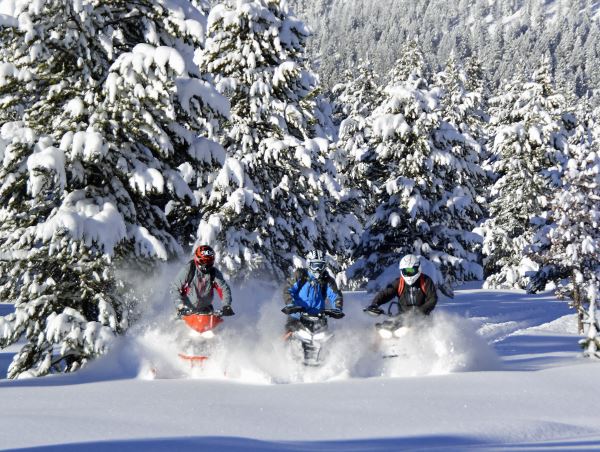
“What They Say”
For the Deep Powder Challenge, our test riders included Ryan Harris, Lane Lindstrom, Taylor Fisk and Justin Stevens. The following is an accumulation of their thoughts on the various aspects of each snowmobile.
POWER
The Ski-Doo delivers silky, smooth power from bottom to top. –LL
The response of the Polaris is incredible. It reminds me of a mod snocross sled. That kind of response really impacts what you can do as far as changing lines and snapping the front end up over obstacles. –RH
For me, the Ski-Doo power style is perfect. It’s snappy down low, strong in the mid and holds on up top. It’s not a top-end rocket, but I’m not a top-end rider. –RH
The Cat has power, if you can harness it. There are some bogs in this motor on the bottom end if you let it idle too long. This motor likes to be run wide open. –TF
CLUTCHING
The Polaris clutching was solid. It pulled 8300 rpm all day in any condition. No complaints about that. –TF
The new Ski-Doo pDrive clutch seems to be working great. The power is right there off the bottom end and the clutching pulls hard all the way to the top. Spot on. –TF
SUSPENSION
Because air doesn’t “give” sometimes, the ride of the Cat can be a little harsh. And to adjust them is a bit of a pain because of having to use the air pump. Not as easy as switching a dial but does have a bigger range of adjustability. –LL
Cat has an excellent suspension. And it should … this mountain sled is based on a race sled platform. –RH
Ski-Doo finally nailed it. This sled is great in the whoops and great in the powder. Not a weak spot between the two. –RH
The Cat comes with one of the more impressive shock packages—Fox Float 3 Evols on all four corners. You’ll need to research settings for these but once you get them dialed in with the supplied air pump, these shocks are flat-out impressive. –TF

The Polaris has an excellent suspension setup for technical mountain conditions. However, it may be rougher down the trail. –JS
The Ski-Doo offers the smoothest ride. It is comfortable on a rough trail into your favorite riding spot. The Ski-Doo is easy on your shoulders and arms. It doesn’t jar you when crossing an old rut in deep powder. –TF
HANDLING
There are a handful of times where the Polaris kind of has a mind of its own, but if you can figure out where the sweet spot is for your feet on the running boards, it is easier to handle. It really does work well. –LL
The Ski-Doo is a steer-with-your-eyes sled. It takes very little rider input … and the input you give it goes a long way. I don’t get tired on this machine. –RH
The Polaris is like a Porsche—very precise handling and by far the most responsive sled to rider input and foot placement. –TF
The Cat’s handling is odd. It doesn’t like to go slow. If you slow down on the Cat you’ll find yourself diving or falling over. The Cat likes to be ridden very aggressively and if you do so, it will hold its line. –TF
SIDEHILLING
The Ski-Doo is very easy to keep on an edge on a sidehill. The chassis just keeps getting better and better as the years go on. –LL
Left or right, the Ski-Doo inspires confidence for sidehilling. –RH
The Ski-Doo holds a sidehill very well. It has a very light front end which makes sidehilling a blast—easy to get over holes, logs and terrain changes. –TF
The Polaris is extremely predictable in all snow conditions. It increases rider confidence since the sled will go where you want it and hold the line. –JS
TRACK
I’m not a fan of the Polaris Series 7 track. I think the 2.6-inch track is more versatile. It seems to drive up onto the snow where the Series 7 3-inch drives through the snow. –RH
The Ski-Doo three-inch track literally changed the perception of three-inch tracks. The new 3.5-inch pitch works flat-out amazing. It hooks up hard on any type of snow—even hardpack. –TF

SKIS
Cat skis don’t have enough flotation for this style of front end and body. –RH
The Polaris Gripper Ski is the Holy Grail of OEM skis. This ski hasn’t changed in years, yet is still best in class. It handles superb down the trail, offers light steering and holds a sidehill and powder carve with ease. –TF
Ski-doo skis have consistent handling in all snow conditions. Its front loop is easy to grab. –JS
RUNNING BOARDS
Traction is great, rigidity is great. How snow freezes to the Polaris and packs onto them is probably the worst of the three. –RH
Although the Ski-Doo Summit X has a superior design to the SP, both provide great footing and snow evacuation. However, they still feel wide at the front. –RH
The Polaris running boards are top notch; lots of traction with huge cutouts. The best trait these boards have to offer is how stiff they are, translating your foot inputs directly to the chassis. –TF
SEAT
Never use the Ski-Doo seat unless the shocks and my ankles and knees fail to absorb an impact. –RH
The Polaris seat is the best of both worlds—flat for a nice platform while trail riding, yet short and stubby enough for jumping around on the sled in the hills. Plus it’s easy to remove and replace. Simple yet effective. –TF
The Polaris seat is not impeding in any way when maneuvering over or around the seat, yet sufficient when you need a seat. It is comfortable even in a standing neutral position. –JS
The Ski-Doo seat is a great improvement. It definitely provides a smaller, less impeding profile than before. –JS
HANDELBARS
The Ski-Doo comes with a very clean bar setup. The only downfall is the OEM riser is a bit too tall which is an easy fix. The bend feels nice and the grips are tacky. –TF
The Arctic Cat grips are a definite improvement. –JS
INSTRUMENTS
The Ski-Doo gauge is simple and readable. That’s all we’ve asked for. –RH
The Ski-Doo has gauges? Can’t see them anyway because of the mountain strap. –LL
The Cat gauge works. It is easy to read rpm and speedometer. It’s not super fancy but it works. If it ain’t broke don’t fix it. –TF

Have an opinion on our results? Tweet us @snowestmagazine